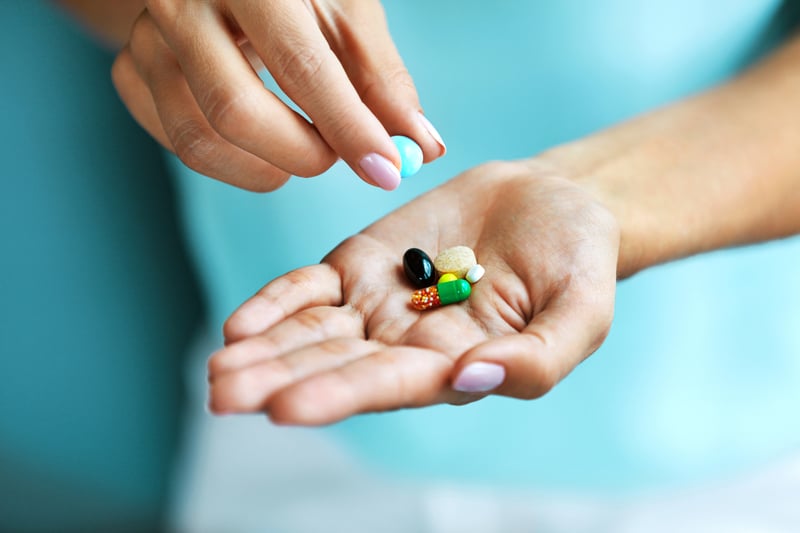Here are 4 Vitamins Every Women Over 40 Should Take Daily

All vitamins and minerals are important; heck, they’re essential. We all need them—either through food, supplements, or a combination. But, ladies, believe it or not, there are some key vitamins women should take. No matter how old you are, nourishing your body with proper amounts of vitamins and minerals is crucial to:
- Support a healthy heart
- Promote brain health and cognitive function
- Help maintain strong, healthy bones
- Promote stress management
- Support healthy hormonal balance
- Help boost metabolism and metabolic function
- Promote energy levels and feelings of well-being
- Support a healthy immune system
- Promote healthy eyesight and visual function
- Help preserve a youthful, vibrant glow
And while they’re all important and deficiencies in any micronutrient can be problematic, we’re going to hone in on a select handful of minerals and vitamins women should take to help bring out (and preserve) their best energy, beauty, and overall awesomeness!
4 Vitamins Women Should Take
Vitamin/Nutrient #1: Vitamin D
• Why YOU should be concerned: At the top of the list of vitamins women should take is vitamin D, which is also referred to as the “sunshine vitamin.” Believe it or not, the bioactive form of vitamin D actually serves as a hormone in the body.1 The role and benefits of vitamin D far surpass healthy bones. Nearly every tissue in the body has a vitamin D receptor, including cells of the pancreas, immune system, skin, thyroid, stomach, colon, and more.2,3 Unfortunately, vitamin D deficiency is prevalent throughout the world.4
Not surprisingly, not having enough vitamin D has been associated with (which should not necessarily be confused with “causative”) a laundry list of health concerns. These include weight gain, poor metabolic function, mood-related issues, poor immune function, declining bone health, decreased muscle strength, and more.
• How much do you need: This is a bit tricky and actually fairly controversial. The Institute of Medicine (IOM) has set a Dietary Reference Intake (DRI) of 600 IU per day for adult men and women. However, for the most accurate assessment of your vitamin D status, you should consider getting your blood levels of 25-hydroxyvitamin D (i.e., [25(OH)D]) tested and base your intake and sun exposure on your results.
• Where you can get it: Sunlight exposure (with your bare skin exposed) is the number one way to boost levels of vitamin D. It’s estimated that sunlight exposure accounts for upwards of 90% of the vitamin D in circulation.5 The best natural food sources include oily fish (e.g., wild salmon, sardines, mackerel), egg yolks, and mushrooms. Dairy products are often fortified with vitamin D as well.
Vitamin/Nutrient #2: Magnesium
• Why YOU should be concerned: Even though it’s not a vitamin, women should still be concerned about magnesium. After all, did you know ALL cells in your body require magnesium? Did you know magnesium is involved in over 300 enzymatic reactions and biological processes? Did you know magnesium plays an important role in energy production, metabolic rate, blood glucose management, protein production, and more?
While most people associate magnesium with bone health (and it’s definitely important to maintain strong bones), magnesium also helps with energy production, exercise performance, mood, feelings of well-being, heart health, glycemic control, muscle soreness, and migraine headaches.
Unfortunately, magnesium deficiency is very common. About 50% of Americans fall well short of the DRI for magnesium. This is not good as magnesium deficiency can increase the risk of type 2 diabetes, metabolic syndrome, Alzheimer’s disease, and cardiovascular disease?6
• How much do you need: The DRI for magnesium is 400 – 420 mg per day for men and 320 – 360 mg per day for women.
• Where you can get it: Dark green leafy vegetables (such as spinach, Swiss chard, turnip greens, beet greens, mustard greens, and kale), legumes, nuts, seeds, and whole grains are all good sources of magnesium.
Vitamin/Nutrient #3: Vitamin E
• Why YOU should be concerned: Going back to actual vitamins women should take, vitamin E is a noteworthy antioxidant. When it comes to promoting healthy aging, supporting the body’s natural antioxidant defense networks is the name of the game.
You see, oxidative stress essentially refers to an imbalance of free radicals and the antioxidants needed to neutralize them. In short, oxidative stress is at the heart of virtually every aspect of aging on every level. For example, it affects your skin (and every other organ for that matter), and it zaps your energy levels. Think of it this way: oxidative stress triggers inflammation. These days, pretty much everyone knows that persistent, unhealthy levels of inflammation are bad news. While there are other antioxidants, vitamin E is often considered at the “forefront” of the body’s free radical defense systems. This makes it a clear choice as one of the top vitamins women should take.7
It’s estimated that over 90% of Americans don’t consume enough vitamin E in its natural form.8 You see, while whole foods naturally package vitamin E (as “mixed tocopherols”), most fortified foods and many supplements contain predominantly a synthetic form of vitamin E known as “dl-alpha tocopherol.” Some studies have shown that vitamin E supplementation may actually increase mortality in patients with cardiovascular disease. And, researchers believe this is because many supplements provide high doses of only synthetic alpha tocopherol (instead of mixed tocopherols, which includes alpha, beta, delta, and gamma isomers).9
• How much do you need: The RDA for vitamin E intake is 15 mg for men and women. Note that vitamin E is typically listed on labels in International Units (IUs), which is a measure of biological activity rather than mass/quantity. For conversion, 1 IU of the natural form of vitamin E is equivalent to 0.67 mg of d-alpha-tocopherol, which is the form of vitamin E measured in the body.
• Where you can get it: Like magnesium, you’ll find vitamin E in dark green leafy vegetables, as well as sunflower seeds, asparagus, almonds, broccoli, bell peppers, and tomatoes. Keep in mind that vitamin E is a fat-soluble vitamin, and along those lines, it’s best when it’s consumed with food.
And while we’re on the topic of antioxidants, let’s not forget about a couple other vitamins women should take: vitamins A and C. These are tremendously important and powerful antioxidative vitamins that can be found in a variety of vegetables and fruits.

Vitamin/Nutrient #4: Potassium
Why YOU should be concerned: Potassium is a mineral and electrolyte essential for overall health. It plays a crucial role in cellular functioning throughout the body, and along those lines, potassium:
- Helps muscles—including the heart—contract
- Helps regulate the balance of water and other minerals
- Moves nutrients into and waste out of cells
- Affects nerve signaling
- Slows the breakdown of bone with age
In terms of health benefits, potassium goes hand-in-hand with heart health, in particular, due to its effects on maintaining healthy blood pressure. In fact, the FDA allows the following health claim: “Diets containing foods that are a good source of potassium (10 percent of the Daily Value, or 350 mg) and that are low in sodium may reduce the risk of high blood pressure and stroke.”
How much do you need: Even though there’s no established Recommended Dietary Allowance (RDA) for potassium, the Adequate Intake (AI) is 4,700 mg for adults based on evidence that this level should lower blood pressure, blunt the adverse effects of excess sodium intake, reduce the risk of kidney stones, and help reduce bone loss.
Unfortunately, most people barely consume half that amount. Even worse, many people are consuming too much sodium from processed foods. In fact, one large study showed that only about 3% of the population hit the AI for potassium.10
Where you can get it: While bananas are notorious for their potassium content (and they are indeed a good source), the truth is many other foods are even better sources, including potatoes, white beans, yogurt, milk, sweet potatoes, salmon, dark green leafy veggies, and avocados, to name a few.








